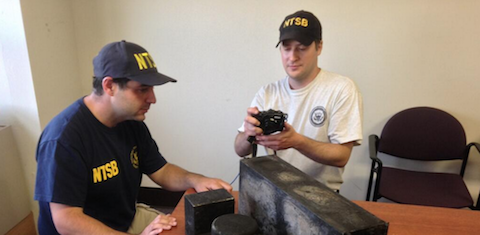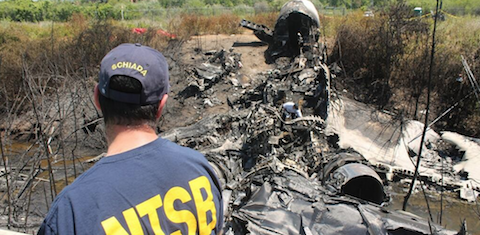Former Nets and Devils owner
killed in plane crash
31 May 2014; Gulfstream IV; N121JM, Hanscom Field, near Boston, MA: Lewis Katz, the former owner of the New Jersey Nets of the NBA and the New Jersey Devils of the NHL was killed when his executive jet crashed while attempting to take off from a Boston area airport. The aircraft was on an unscheduled flight form Hanscom Field in Bedford, MA to Atlantic City, NJ, and according to a witness, the aircraft attempt a takeoff, but did not become airborne.
After departing the runway, the aircraft struck a localizer antenna (used for instrument landing approaches) and a fence before proceeding down an embankment and coming to rest about 1,850 feet beyond the end of the runway, in a gully formed by a small river. Multiple witnesses reported hearing an explosion and seeing a fireball. The photo below from the NTSB shows that the aircraft broke up and had caught fire.

The aircraft was equipped with both a cockpit voice recorder and a flight data recorder, both of which were recovered and are currently being analyzed by the NTSB.

All seven occupants, including two flight crew members, a cabin crew member, and four passengers were killed. Although the authorities have not determined a cause of death, given the location of the crash site and the condition of the aircraft, it is likely that the fatal injuries were due to the effects of a combination of impact forces, smoke or fume inhalation, and burns.
Among the four passengers was Lewis Katz, a prominent entrepreneur and philanthropist who was a former owner of the New Jersey Nets and New Jersey Devils, and a current part owner of the Philadelphia Inquirer newspaper.
An AirSafe.com review of the online incident and accident databases of the NTSB and FAA show no prior accidents or serious incidents involving the accident aircraft. The aircraft was owned by SK Travel, LLC, of Raleigh, NC (a company co-owned by one of the passengers), and there were no indication of those same databases of any previous accident or serious incident involving this company.
According to Gulfstream Aerospace, 536 Gulfstream IV aircraft were produced from 1985 until 2002. The aircraft involved in the Hanscom Field accident was manufactured in 2000.
According to Aviation-Safety.net, a site run by the Flight Safety Foundation, there have been four fatal events involving the Gulfstream IV, including the recent crash at Hanscom Field, that resulted in the death of one or more people either inside or outside of the aircraft.
NTSB preliminary report - 13 June 2014
The NTSB preliminary report included the following key findings:
- Tire marks consistent with braking were observed to begin about 1,300 feet from the end of runway 11. The tire marks continued for about another 1,000 feet through the paved runway safety area.
- The airplane's ground roll began about 49 seconds before the end of the CVR recording.
- FDR data indicated the airplane reached a maximum speed of 165 knots during the takeoff roll, and did not lift off the runway.
- The FDR data ended about seven seconds after thrust reverser deployment, with the airplane at about 100 knots.
- The airplane was equipped with a mechanical gust lock system, which can lock the ailerons and rudder in the neutral position and the elevator in the down position, to protect the control surfaces from wind gusts while parked.
- The FDR data revealed the elevator control surface position during the taxi and takeoff was consistent with its position if the gust lock was engaged. The gust lock handle was found in the forward (OFF) position, and the elevator gust lock latch was found not engaged.
- Review of FDR data parameters associated with the flight control surface positions did not reveal any movement consistent with a flight control check prior to the commencement of the takeoff roll.
In an interview conducted shortly after the preliminary report was released, former NTSB Board Member John Goglia suggested that this lack of flight control movement prior to takeoff indicated that the crew did not complete a standard preflight checklist.
NTSB final report - 28 September 2015
In the final report of the accident, the NTSB determined that the probable cause of this accident was the flight
crewmembers' failure to perform the flight control check before takeoff, their attempt to take off
with the gust lock system engaged, and their delayed execution of a rejected takeoff after they
became aware that the controls were locked. Contributing to the accident were the flight crew's
habitual noncompliance with checklists, Gulfstream Aerospace Corporation's failure to ensure
that the G-IV gust lock/throttle lever interlock system would prevent an attempted takeoff with
the gust lock engaged, and the Federal Aviation Administration's failure to detect this
inadequacy during the G-IV's certification.
Related resources
NTSB accident report
NTSB preliminary report
Celebrity plane crashes
Historical celebrity crashes
http://www.airsafe.com/events/celebs/katz.htm -- Revised: 1 May 2017